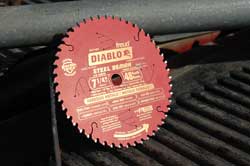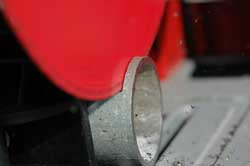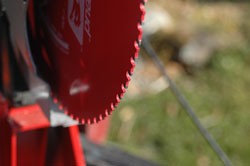 Cutting all kinds of steel and ferrous metal is easier and more accurate than ever, and these productivity gains come from a very unlikely source: carbide-tooth saw blades. These blades look like wood-cutting blades, except they work almost as quickly chewing through steel, both thick and thin.
Cutting all kinds of steel and ferrous metal is easier and more accurate than ever, and these productivity gains come from a very unlikely source: carbide-tooth saw blades. These blades look like wood-cutting blades, except they work almost as quickly chewing through steel, both thick and thin.
Advances in metallurgy and tooth design allow ferrous cutting blades to create not only very precise cuts, but sawn parts are also cool enough to touch immediately after they fall off the saw. Cuts are virtually burr-free and generated without sparks.
There are two ways you can use ferrous-cutting blades. Smaller sizes are made to fit into hand-held circular saws; ideal for cutting steel studs, thin-gauge angle iron and small rod. But with heavier angle iron, pipe and bar stock, the precision and productivity of a chopsaw pays off. The largest ferrous metal blades need to spin slower than wood blades, so they must be used in designated metal-cutting chopsaws only. The biggest reason why is rotational speed.
 Ferrous chopsaw blades are big – typically 14 inches in diameter – and this makes for a comparatively high tooth speed for any given RPM. Proper saws for this application max out at 1800 rpm, about half the speed of a comparable wood-cutting chopsaw.
Ferrous chopsaw blades are big – typically 14 inches in diameter – and this makes for a comparatively high tooth speed for any given RPM. Proper saws for this application max out at 1800 rpm, about half the speed of a comparable wood-cutting chopsaw.
Another reason ferrous blades work best in metal-cutting chopsaws is the stock-holding features they have. Metal saws have built-in clamps that hold the work securely, eliminating any possibility of kickback. The best saws can also be easily adjusted for cutting angles from 0° to 45°.
Working with a ferrous blade is a much more civilized operation than using the kind of abrasive wheel chopsaws that are traditionally used for stationery metal cutting. Ferrous blades cut more quickly and more quietly (though you should still wear hearing protection). And you don’t have to take the same fire precautions since they don’t generate a plume of sparks as long as the blade is sharp.
 You can expect hundreds of cuts from an industrial quality ferrous blade, but you can extend blade life by making each cut at the right speed. Proceed too slowly through the cut and you’ll generate excess heat that dulls teeth quicker. Cut too fast and you could chip teeth because of the strain. The ideal downward chopping speed is about half as fast as you’d go through a 2 x 6 with a wood saw. It doesn’t take long to get a feel for what’s right.
You can expect hundreds of cuts from an industrial quality ferrous blade, but you can extend blade life by making each cut at the right speed. Proceed too slowly through the cut and you’ll generate excess heat that dulls teeth quicker. Cut too fast and you could chip teeth because of the strain. The ideal downward chopping speed is about half as fast as you’d go through a 2 x 6 with a wood saw. It doesn’t take long to get a feel for what’s right.
Ferrous blades leave your shop and worksite cleaner than abrasive wheels because the size of metal filings generated is much larger. Most saws include a removable tray that catches about 80% of the stuff kicked back during each cut. This material isn’t really filings – it’s too large to be called that – it’s more like very coarse metal sawdust that’s bluish black in color because of the friction generated as the curls of steel were pulled off during each cut.
Whether you use ferrous cutting blades in a hand-held circ saw, a chopsaw or both, they’re one small way you can get metal cut and fitted faster and better than ever.